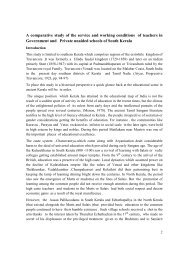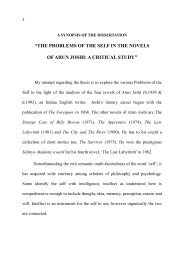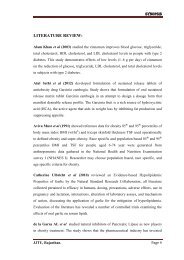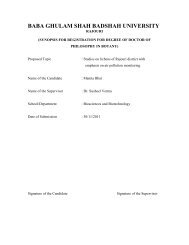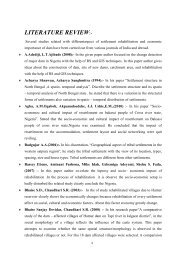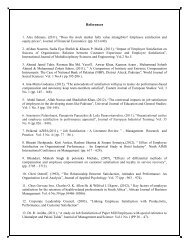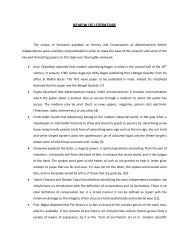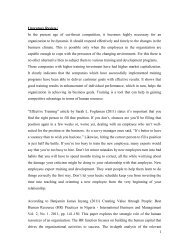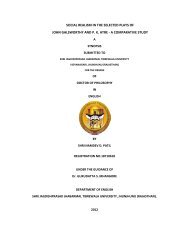PhD Synopsis Arun Babu Zachariah - ShodhGangotri: Repository of ...
PhD Synopsis Arun Babu Zachariah - ShodhGangotri: Repository of ...
PhD Synopsis Arun Babu Zachariah - ShodhGangotri: Repository of ...
You also want an ePaper? Increase the reach of your titles
YUMPU automatically turns print PDFs into web optimized ePapers that Google loves.
A comparative study <strong>of</strong> the service and working conditions <strong>of</strong> teachers in<br />
Government and Private unaided schools <strong>of</strong> South Kerala<br />
Introduction<br />
This study is limited to southern Kerala which comprises regions <strong>of</strong> the erstwhile kingdom <strong>of</strong><br />
Travancore .It was formerly a Hindu feudal kingdom (1729-1858) and later on an Indian<br />
princely State (1858-1947) with its capital at Padmanabhapuram or Trivandrum ruled by the<br />
Travancore royal Family. Travancore (Venad) was located on the Malabar Coast, South India<br />
in the present day southern districts <strong>of</strong> Kerala and Tamil Nadu. (Aiyar, Progressive<br />
Travancore, 1923, pp. 94-97)<br />
To place this study in a historical perspective a quick glance back at the educational scene in<br />
ancient Kerala will be in order.<br />
The unique position which Kerala has attained in the educational map <strong>of</strong> India is not the<br />
result <strong>of</strong> a sudden spurt <strong>of</strong> activity in the field <strong>of</strong> education in the recent times, but the climax<br />
<strong>of</strong> the enlightened policies <strong>of</strong> its rulers from early days and the intellectual pursuits <strong>of</strong> the<br />
people spread over several centuries. (Menon, 1978). The ancient Tamil Sangam literature<br />
testifies to the high level <strong>of</strong> literacy obtained in Kerala , the people irrespective <strong>of</strong> sectarian or<br />
gender considerations getting the benefits <strong>of</strong> education. For instance , the communities like<br />
Kuravas , Parayas and Vetas reckoned as inferior in social scale in the later ages, were held<br />
in high esteem by kings and nobles. During this period Matilakam near Muziris was one <strong>of</strong><br />
the important places <strong>of</strong> educational excellence.<br />
The caste system –Chaturvarnya-which came along with Aryanisation dealt considerable<br />
harm to the ideal <strong>of</strong> universal education which prevailed during early Sangam age. The age <strong>of</strong><br />
the Kulasekharas in South Kerala (800 -1100) saw a revival <strong>of</strong> learning with Salais or vedic<br />
colleges getting established around major temples. From the 9 th century to the arrival <strong>of</strong> the<br />
British, education was a preserve <strong>of</strong> the high caste. Local dynasties which assumed power on<br />
the decline <strong>of</strong> Kulasekhara empire like the rulers <strong>of</strong> Venad and other kingdoms like<br />
Thekkumkur, Vadakkumkur ,Chempakasseri and Kolathiri did their patronising best in<br />
keeping the lamp <strong>of</strong> learning shining bright down the centuries. In North Kerala, the period<br />
also saw the emergence <strong>of</strong> Mutts or madoms) on the lines <strong>of</strong> Salais. But the promotion <strong>of</strong><br />
learning among the common people did not receive enough attention during this period. The<br />
high caste teachers and students in the Mutts or Salais had both social respect and decent<br />
economic gains as a result <strong>of</strong> the royal munificence .<br />
However, the Asaan Pallikoodams in South Kerala and Ezhuthupallys in the North Kerala<br />
(that existed alongside the Mutts and Salais )that provided basic education to the common<br />
people continued to have their humble existence . Such village schools received a shot in the<br />
arm thanks to the interest taken by Thunchat Ezhuthachan in the 17 th century, who made no<br />
secret <strong>of</strong> his displeasure at the privileged treatment given to the Brahmins and to Sanskrit<br />
2
education. The asaan /ezhuthachan ( village teacher) received social respect and modest<br />
economic gains unlike the high caste teachers in the Mutts or Salais.<br />
The contribution <strong>of</strong> the Portuguese and the Dutch in comparison to the British was rather<br />
marginal, notwithstanding the prototype printing press which was established by the<br />
Portuguese. The Church Missionary Society (CMS ) and London Missionary Society (LMS )<br />
missionaries who landed in Travancore in 1816 at the instance <strong>of</strong> the British resident <strong>of</strong><br />
Travancore , Col. Monroe played a significant role in the progress <strong>of</strong> education in Kerala<br />
by compiling dictionaries and grammar books besides establishing schools and colleges.<br />
The pioneering impact <strong>of</strong> Protestant missionaries Ringle Taube and Dr Mead <strong>of</strong> LMS on<br />
formal education prompted Rani Gauri Parvathy Bai to promulgate the Rescript <strong>of</strong> 1817<br />
under which “ the state should defray the whole cost <strong>of</strong> education <strong>of</strong> its people, in order that<br />
there might be no backwardness in the spread <strong>of</strong> enlightenment among them.” (Pillai, 1940,<br />
p. 700)<br />
According to V Nagam Aiya (1989, p.443) “education in the modern sense <strong>of</strong> the term in<br />
Travancore may be said to date from the year 1834 AD” when the first English School was<br />
established. But it was in 1867 that the government initiated steps to put vernacular schools<br />
on a sound basis. The dual control <strong>of</strong> the English and Vernacular schools was done away with<br />
in 1894 . Prior to this , two systems <strong>of</strong> grant in aid, one for vernacular schools and another<br />
for English schools were in place .But the rules regulating the grants were rather haphazard.<br />
The new Grant in Aid Code <strong>of</strong> M.E. 1070, dealing with rules for classification <strong>of</strong> schools,<br />
fixing standards <strong>of</strong> instruction ,qualification <strong>of</strong> teachers in aided schools etc. in addition to<br />
award <strong>of</strong> grants for running the schools was published in 1894. (Aiya, 1989, p. 491).<br />
Ever since 1817 the government has played a decisive role in the laying down <strong>of</strong> rules,<br />
regulation <strong>of</strong> functions, provision <strong>of</strong> finance and management <strong>of</strong> schools. However, the<br />
present phenomenon <strong>of</strong> private unaided schools constitutes a significant exception to this<br />
historical trend.<br />
In this context it should be remembered that the famous Education bill <strong>of</strong> 1957 framed at the<br />
instance <strong>of</strong> Kerala’s first Minister <strong>of</strong> Education, Joseph Mundassery legalised the role <strong>of</strong><br />
private school management. Three categories have come into being; Government, Aided<br />
where government pay the salary <strong>of</strong> the staff members <strong>of</strong> the private school and Unaided<br />
where management <strong>of</strong> the school has to meet the salary requirement <strong>of</strong> the teachers though the<br />
school is recognised. A healthy competition among these three categories proved to be a<br />
better market oriented solution to many issues faced in the education sector like infrastructure<br />
facilities, quality <strong>of</strong> education and enrolment rate <strong>of</strong> the children. Teaching became the most<br />
sought after pr<strong>of</strong>ession in Kerala while Education sector evolved into a major service sector<br />
activity.<br />
3
The wide spread educational development was facilitated by easy access to Lower Primary<br />
(LP), Upper Primary (UP) and High School (HS) education in Kerala. For instance among the<br />
rural population 94.39 per cent is served by primary schools within a distance <strong>of</strong> 1 kilometer ,<br />
96.2 per cent with an upper primary school within three kilometers and 97.82 percent with a<br />
secondary schools within a radius between six and eight kilometers. Economic Review <strong>of</strong><br />
2004 says that there are 12, 322 schools in Kerala for 48.94 lakhs enrolled students. Among<br />
them private sector manages 63.5 per cent schools with 67 percent students and 66.6 per cent<br />
teachers in the Kerala schools scenario.<br />
In 1904 the government took upon itself the vital responsibility to <strong>of</strong>fer free primary<br />
education . (Aiya, 1989, p. 443) A sure component <strong>of</strong> human resource development , literacy<br />
has recorded phenomenal growth over the last few decades. The literacy rate <strong>of</strong> Kerala that<br />
was 47.18% in 1951 almost doubled to 90.92% as per the 2001 census while the national<br />
average remained 65.38%. Further the regional and gender disparity in Kerala was<br />
significantly low . Prevalence <strong>of</strong> schools in every nook and corner <strong>of</strong> the state accounted for it<br />
, schools under private management stealing a march over the government counterparts in this<br />
exercise. The number <strong>of</strong> schools in the private sector <strong>of</strong>fered stiff competition by raising the<br />
bar <strong>of</strong> teaching standards. The state has a history <strong>of</strong> over two hundred years <strong>of</strong> private<br />
‘edupreneurs’.<br />
As <strong>of</strong> the year 2008-09 (Selected Educational Statistics 2008-09, 2010) Kerala has 1,74,978<br />
teachers, 54,300 in government , 1,06,143 in aided school and 14,535 in unaided schools<br />
<strong>of</strong>fering SSLC syllabus. As against 999 government high schools there are 1429 government<br />
aided high schools and 375 unaided high schools following state syllabus. Of higher<br />
secondary schools 735 are directly run by the government while 529 are aided and 439<br />
private unaided schools. Government vocational higher secondary schools number 261<br />
while private aided Vocational higher secondary schools number 128. Of the 1720<br />
uneconomic government schools ( High school, Upper Primary and Lower Primary<br />
government schools together) in south Kerala, Trivandrum has 145,Kollam133,<br />
Pathanamthitta 178, Alapuzha 172, Kottayam 205 and Idukki 85.<br />
In 2008-09 there were 587 CBSE schools in Kerala ( Trivandrum 51 + Pathanamthitta 26+<br />
Kottayam 48)which had 3,81,852 students on their roles and employed 16,002 teachers<br />
whereas 100 - ICSE Schools in Kerala ( Trivandrum and Pathanamthitta claimed 13 each and<br />
Kottayam 8) had 66,188 students and employed 2,122 teachers. (Selected Educational<br />
Statistics 2008-09, 2010)<br />
The wide disparity between the working conditions <strong>of</strong> teachers in government and private<br />
unaided schools has been firmly established by the findings <strong>of</strong> different studies . Among other<br />
factors working and service conditions significantly influence teacher effectiveness. Effective<br />
education leads to effective society. The most important agent in educational process which<br />
leads to reconstruction <strong>of</strong> society is the teacher. The students , parent and society at large feel<br />
the pulse <strong>of</strong> education through the teacher. But “private unaided schools remain largely<br />
4
eyond the domain <strong>of</strong> government control and regulation; in many instances they do not fall<br />
under any form <strong>of</strong> public accountability at all. However, certain regulatory measures were in<br />
fact introduced by the government by adding a new Chapter XIV (AA) to the Kerala<br />
Education Rules” relating to the conditions <strong>of</strong> service <strong>of</strong> teaching and non-teaching staff <strong>of</strong><br />
recognised unaided schools .This was made as per the Gazette notification dated 30/03/1990.<br />
Surprisingly, the state government itself which enacted this rule stayed the implementation <strong>of</strong><br />
the rules soon after its introduction.” (Baby & Pillai, 2008, p. 8)<br />
The Secondary Education Commission1952-53( Mudaliar Commission) advocated that<br />
teachers should be given better conditions <strong>of</strong> service such as attractive pay, pension, provident<br />
fun , the Indian Education Commission 1964-66( Kothari Commission) laid special emphasis<br />
on the improvement <strong>of</strong> teachers’ economic, social and pr<strong>of</strong>essional status and the National<br />
Policy on Education 1986 states that the status <strong>of</strong> the teacher reflects the socio-cultural ethos<br />
<strong>of</strong> a society (Shukla, 1988) .<br />
Chronic unemployment (Sunny, 2000) <strong>of</strong> a large proportion <strong>of</strong> the active labour force has<br />
been the most serious socio economic problem <strong>of</strong> Kerala for the past several years. In this<br />
background it must be admitted that though the private unaided educational sector has been a<br />
significant service provider in the state all is not well with the condition <strong>of</strong> its employees as in<br />
government sector .<br />
The main argument in this thesis is that the government and the community should endeavour<br />
to create conditions that motivate the creativity and pr<strong>of</strong>essionalism <strong>of</strong> all educators working<br />
in government, aided or private schools.<br />
Statement <strong>of</strong> the problem:<br />
The study compares the Service and Working Conditions <strong>of</strong> the teachers in Kerala’s<br />
Private Unaided Schools with that <strong>of</strong> the Government Schools.<br />
Methodology in brief :<br />
The present study uses a mix <strong>of</strong> both qualitative and quantitative research techniques .Mixed<br />
methods are used depending on the situation to derive maximum data for the ‘comparison <strong>of</strong><br />
working and service conditions <strong>of</strong> teachers’ in South Kerala.<br />
The study made use <strong>of</strong> primary data, secondary data, questionnaires and interviews for data<br />
collection.<br />
The population <strong>of</strong> the present study is the Government School teachers and Unaided Private<br />
School teachers <strong>of</strong> South Kerala. As the number <strong>of</strong> teachers was quite large a smaller sample<br />
was selected.<br />
By multi stage random sampling, out <strong>of</strong> the 265 CBSE schools – 54 CBSE were selected<br />
from in the six districts <strong>of</strong> South Kerala namely Thiruvananthapuram, Kollam,<br />
Pathanamthitta, Alapuzha, Kottayam and Idukki .There are 18 DEO’s in the six districts.<br />
Considering the homogenous nature <strong>of</strong> the service and working conditions <strong>of</strong> the government<br />
5
higher school teachers only one school was selected from each <strong>of</strong> these eighteen DEO<br />
divisions. Three teachers were administered the questionnaire – one each from Primary,<br />
Secondary and Higher Secondary division. Thus a total <strong>of</strong> 54 teachers were included in the<br />
Government Higher schools category. Taking into account the heterogeneous nature <strong>of</strong> the<br />
working condition <strong>of</strong> the working and service condition <strong>of</strong> CBSE schools three schools were<br />
selected from each DEO limit. So 54 CBSE schools were selected and three teachers were<br />
selected from each schools – belonging to primary, secondary and higher secondary levels.<br />
162 teachers were selected from the CBSE schools.<br />
The data obtained from the sample are scrutinised and only those found complete and correct<br />
was accepted. Scaling technique was employed to ascertain the attitude <strong>of</strong> teacher towards<br />
working conditions and overall satisfaction. The results were subjected to analysis using<br />
statistical techniques and tools including percentages, and two sample t-test was used to test<br />
the tenability <strong>of</strong> hypotheses.<br />
Need and Significance <strong>of</strong> the Study:<br />
The achievements <strong>of</strong> Kerala in social development (http://www.education.kerala.gov.in/) and<br />
quality <strong>of</strong> life have helped the state record a human development index comparable to the<br />
developed countries <strong>of</strong> the World. Nobel laureate Amartya Sen (Sen, 1999)has attributed<br />
Kerala’s achievements largely to the higher priority given to education for a long time<br />
compared to the other Indian states. This is because Kerala society has given so much<br />
importance to education and the endeavours to improve the quality <strong>of</strong> education.<br />
The role <strong>of</strong> teachers in improving the standard <strong>of</strong> education in this highly literate state has<br />
been uniformly acknowledged. Yet the wide disparity between the service and working<br />
conditions <strong>of</strong> government and private unaided school teachers remain alarming. As such the<br />
main thrust <strong>of</strong> this study is to highlight the fact that the job security and social standing born<br />
out <strong>of</strong> the decent salary and perks assured to the government school teachers were way<br />
beyond the reach <strong>of</strong> private unaided school teachers. The major grievance <strong>of</strong> the private<br />
school teachers , therefore, is that there is a wide disparity in the salary and perks which their<br />
government school counterparts enjoy, making them feel less secure and self assured. This is<br />
a serious problem which the government <strong>of</strong> the state should address promptly ,lest it should<br />
affect the morale <strong>of</strong> the private school teachers whose contribution to the realm <strong>of</strong> school<br />
education is no less vital.<br />
The statistics given below would give the contention greater clarity :<br />
Between the years 2002-03 to 2005-06 , against 386 new unaided schools only 6 new<br />
government schools and 8 new aided schools were started . (Kerala, 2006). While in the<br />
academic year 2003-04 there were only 8187 teachers in unaided schools <strong>of</strong> Kerala out <strong>of</strong> a<br />
total <strong>of</strong> 1,73,807 teachers ( in government, aided and private unaided schools together ) in<br />
the academic year 2005-06 the number <strong>of</strong> teachers in private unaided schools increased to<br />
31,398 . (Politics <strong>of</strong> education, 2005)<br />
6
In this context the present study has great relevance and significance. The study compares the<br />
Service and Working Conditions <strong>of</strong> teachers in Government and Private Unaided Schools <strong>of</strong><br />
Kerala State .<br />
It is hoped that the outcome <strong>of</strong> the research will provide valid insights to the policy framers<br />
and the echelons <strong>of</strong> private management institutions on the hardships and frustration <strong>of</strong> the<br />
teachers in unaided private management schools. It might also inspire them to introspect as to<br />
whether the prevailing academic milieu is conducive for the teachers to work to their full<br />
potential.<br />
Hypotheses:<br />
1. There will not be significant difference between <strong>of</strong> private school teachers and government<br />
school teachers on the variable working conditions despite the structure <strong>of</strong> school<br />
ownership.<br />
2. There will be not be significant difference between private school teachers and<br />
government school teachers on the variable service conditions despite the structure <strong>of</strong> school<br />
ownership.<br />
3. There will not be significant difference between private school teachers and government<br />
school teachers on the variable self perception <strong>of</strong> teachers despite the structure <strong>of</strong> school<br />
ownership.<br />
Objectives:<br />
1) To analyse the evolution <strong>of</strong> service conditions <strong>of</strong> teachers in private unaided schools<br />
with that <strong>of</strong> government schools.<br />
2) To compare the service conditions <strong>of</strong> teachers in private unaided schools with that <strong>of</strong><br />
government schools .<br />
3) To compare the working conditions <strong>of</strong> teachers in private unaided schools with that <strong>of</strong><br />
government schools .<br />
4) To study the self perception <strong>of</strong> teachers in the private unaided schools and government<br />
schools.<br />
5) To find out the impact <strong>of</strong> competition between private and government schools on the<br />
students<br />
Limitation <strong>of</strong> the study:<br />
As the study on the service and working conditions <strong>of</strong> the private unaided schools and<br />
government schools in the entire state <strong>of</strong> Kerala is too vast, the framework <strong>of</strong> study is limited<br />
to schools in the five south Kerala districts namely - Thiruvananthapuram, Kollam,<br />
Pathanamthitta, Kottayam and Idukki. The Right to Education Act (RTE)has not been dealt<br />
with in detail as it deals mainly with the rights <strong>of</strong> students and fixing the glitches <strong>of</strong> education<br />
7
that has hindered universalisation <strong>of</strong> education in India. Moreover, the RTE which has yet to<br />
be implemented in its true spirit is undergoing constant changes.<br />
Definition <strong>of</strong> key terms<br />
Operational definition <strong>of</strong> key terms :<br />
1.Working Condition : It is the real physical environment in which the teacher is working<br />
that influences the teaching learning process . This includes the physical infrastructure like<br />
condition and facilities available in classroom, staffroom, paraphernalia provided to facilitate<br />
teaching like – benches ,tables, writing board , library , audio visual aids etc. and other<br />
facilities like play grounds toilets ,means <strong>of</strong> conveyance etc.<br />
2. Service conditions : include the non physical factors in the school environment which<br />
influence the teaching learning process. This comprises - salary, provident fund, insurance,<br />
casual leave , maternity leave, sick leave, number <strong>of</strong> holidays , training imparted , existence or<br />
right to form unions or associations etc., and laws, rules and statutes to protect the teachers.<br />
3. Private unaided schools – basically include the CBSE schools in Kerala as they form the<br />
maximum number in the unaided sector in Kerala.<br />
Organization <strong>of</strong> the report / Analysis :<br />
The study is divided into six chapters.<br />
The first chapter deals with the introduction, nature and scope <strong>of</strong> the study<br />
The second chapter deals with literature review on the area <strong>of</strong> investigation<br />
The third chapter deals with theoretical overview pertaining to the area <strong>of</strong> investigation<br />
The fourth chapter deals with the description <strong>of</strong> methodology, sample selected, tools and<br />
techniques<br />
The fifth chapter presents a detailed analysis followed by a discussion <strong>of</strong> results and<br />
tenability <strong>of</strong> hypotheses<br />
The sixth chapter summarises the study in retrospect by presenting the findings ,<br />
recommendations and suggestions for future research and conclusion<br />
This is followed by Bibliography and Appendices<br />
Major findings<br />
Working conditions <strong>of</strong> teachers in government and private unaided school s<br />
On the question <strong>of</strong> working conditions private unaided schools have a definite edge over<br />
their government counterparts.<br />
1) Having cropped up only in the 1980’s and most <strong>of</strong> them much later, the private schools are<br />
<strong>of</strong>ten established in walled campuses (96.2% ) . But among government schools 70.4% had<br />
8
compound wall and 29.6% did not have compound walls . This ensured the greater degree<br />
<strong>of</strong> security and privacy to the students .<br />
2) Private schools, most <strong>of</strong> them having concrete ro<strong>of</strong>s, have much better infrastructure than<br />
government schools . According to response <strong>of</strong> teachers 85.2 % had only concrete ro<strong>of</strong>s,<br />
1.2% tile ro<strong>of</strong> and 13.6 had both concrete and tile ro<strong>of</strong>, whereas among government schools<br />
there were no schools with concrete ro<strong>of</strong> alone , 9.3% had only tile ro<strong>of</strong> and 90.7% had both<br />
concrete and tile ro<strong>of</strong>.<br />
3) At least 80 % private unaided schools had three or more than three acres <strong>of</strong> campus with<br />
provision for at least two or three play grounds whereas only 63% government schools could<br />
claim s the same .<br />
4) While hundred per cent <strong>of</strong> private unaided schools have adequate number <strong>of</strong> tables and<br />
chairs for teachers in classrooms only 42.6 %government schools had adequate number <strong>of</strong><br />
chairs for teachers and 48. 1% adequate number <strong>of</strong> tables for teachers.<br />
5) 99.4% private unaided schools have adequate number <strong>of</strong> desks and benches in good<br />
condition for students and tables and chairs for teachers whereas only 66.7 government<br />
schools had adequate number <strong>of</strong> desks and benches in good condition for students.<br />
6) While 84% private schools had water purifier ensuring safe drinking water among<br />
government schools 66.7 % depend on well water or tap water.<br />
7) While 95.7 % <strong>of</strong> the private unaided school classrooms have lights and fans only 25.9 %<br />
government schools have the same. Meanwhile 14.8% government schools were partially<br />
electrified .So it is quite evident that private schools provided better facilities for teacher<br />
ensuring better teaching learning setting.<br />
8) In private unaided schools 71.6% <strong>of</strong> government school teachers rated the condition <strong>of</strong><br />
teachers toilets as good, 24.7% average and 3.4% bad. But in government schools all the<br />
teachers ( 100% ) teachers said the condition <strong>of</strong> teacher toilets was just average .<br />
9) In respect <strong>of</strong> adequate number and condition <strong>of</strong> toilets for students , among private<br />
schools 41.4 % are rated good ,58% average and .6% bad. Whereas among government<br />
schools 7.4% are good, 53.7% average and 38.9% bad.. So it is quite evident that government<br />
schools were not able to provide better facilities to students which had a bearing on the<br />
enrolment <strong>of</strong> students in the government schools.<br />
10) In terms <strong>of</strong> library and librarians among private schools while 89.5% had library<br />
and 98.8% had librarian among government schools 74 .1 % had a library and few had a post<br />
for a librarian. Government schools could not match the library facilities <strong>of</strong> private schools .<br />
Service Conditions <strong>of</strong> private unaided school and government school teachers<br />
1) As regards the service conditions, government teachers leave their unaided counterparts<br />
gasping far behind, especially in the matter <strong>of</strong> job security. While 98% <strong>of</strong> government<br />
9
teachers are permanent only 58% <strong>of</strong> private unaided school teachers can claim any sense <strong>of</strong><br />
permanence in tenure. The rest <strong>of</strong> them are either contract or temporary.<br />
2) The chances for promotion <strong>of</strong> private unaided school teachers also hang in the balance,<br />
favourites <strong>of</strong> the management getting the nod more <strong>of</strong>ten than not. 100% government school<br />
teachers and 11.7% private unaided school teachers said they had prospects for promotion<br />
and career advancement. While in private unaided school only rarely does a teacher get to<br />
become a Vice Principal. Often they end up being a department head or head <strong>of</strong> a section,<br />
primary for instance. Principals’ post is usually filled up from outside , or only from<br />
favourites in the managements’ good books. All the same they are not free from fear <strong>of</strong><br />
demotion. In a government school, a teacher has career growth prospect <strong>of</strong> becoming a<br />
Headmaster / Principal/ AEO/DEO etc.<br />
3) Regarding workload also while in government schools it is evenly distributed private<br />
teachers find themselves with odds heavily loaded against them. The weekly working hours<br />
<strong>of</strong> between twenty one to thirty hours includes 77.8 % private unaided school teachers and<br />
100 % government school teachers. The maximum duration <strong>of</strong> work in a week, which is<br />
above thirty hours, is turned in by 21% private sector teachers, whereas there are no<br />
teachers from government school in this category. The already heavy workload is enhanced<br />
by Comprehensive and Continuous Evaluation (CCE) . Neither the government nor CBSE<br />
seems to acknowledge this aspect.<br />
4) It is on the question <strong>of</strong> salary that the private unaided school teachers finds himself or<br />
herself dealt sorely. While 74% <strong>of</strong> private school teachers collect the minimum monthly<br />
salary between Rs 3000 and Rs 7000 only 5.6% government teachers collect a minimum<br />
monthly salary <strong>of</strong> between Rs 8000 and Rs 12,000.<br />
5) Similarly while no private unaided school teachers received a monthly salary above Rs<br />
30,000 about 50% <strong>of</strong> government school teachers received a monthly salary ranging<br />
between Rs 27,000 Rs39,000.<br />
6) As regards perks such as provident fund, insurance and annual increment private unaided<br />
school teachers find themselves short-changed as opposed to government teachers who get all<br />
benefits as per the government prescribed norms. For instance with regard to annual<br />
increment , while 45.7 % <strong>of</strong> private unaided school teachers collect a minimum annual<br />
increment ranging between Rs zero and Rs 250, none <strong>of</strong> the government teachers got such a<br />
low increment. The minimum annual increment ranging between Rs 250 and Rs 500 was<br />
received by 25.9% government teachers. Maximum increment received by private unaided<br />
school teacher was between Rs 751 and Rs 1000 ( 7.4%) whereas among government school<br />
teachers the maximum annual increment was between Rs 1001 and Rs 1250 ( 16.7%) . The<br />
wide disparity exists mainly due to the fact that the temporary / contract teachers among the<br />
private unaided schools do not receive any annual increment.<br />
10
7)The picture is hardly different in the case <strong>of</strong> Provident Fund (PF) .16.7% private unaided<br />
school teachers did not respond to the question, while a majority <strong>of</strong> 63.6% private unaided<br />
teachers and 5% <strong>of</strong> government school teachers claimed the minimum PF amount between Rs<br />
zero and Rs 1000. Maximum PF claimed by 2.5% private unaided school teachers was<br />
between Rs 3001 and Rs 4000 whereas the maximum PF claimed by government school<br />
teachers ( 20%) was between Rs 9000 and Rs 10,000.<br />
8) The percentage <strong>of</strong> private unaided teachers covered by Insurance was none too<br />
encouraging. From the private unaided school teachers 46.3% said they did not know the<br />
amount and 26.5% that they did not receive any insurance, 19.1% paid insurance premium<br />
between Rs zero and Rs 100 , 6.2% between Rs 101 and Rs 200 , 1.2% between Rs301 and<br />
Rs 400 and .6% between Rs401 and Rs 500. Meanwhile among government school teachers<br />
50% paid insurance premium between Rs Rs3001 and Rs 400 , 30% paid between Rs 401<br />
and Rs500 and 20% paid between Rs 500 and Rs 600.<br />
9) Among private unaided school teachers only 72% collect full salary during summer<br />
vacation and 8% do not get any summer vacation salary at all. Others depend on the<br />
managements whims. As opposed to this trend 100% <strong>of</strong> government school get full<br />
summer vacation salary.<br />
10) Concerning number <strong>of</strong> summer vacation leave in a year, one month leave was got by<br />
2.5% private unaided school teachers and 60% government school teachers . One and half<br />
months leave was received by 37% private unaided school teachers and 10% government<br />
school teachers. The government teachers said that though government education rules<br />
entitled them to an annual vacation <strong>of</strong> two months, in reality they did not get that many days<br />
vacation. Evaluation, publication <strong>of</strong> result , special classes for ninth to twelfth , orientation<br />
courses , campus etc. were all done during the summer vacation.<br />
11) Apart from it all, in the matter <strong>of</strong> maternity leave there was no uniformity between and<br />
within the private unaided school . While 13% private unaided schools provide one month’s<br />
leave and 18.5% provide two months’ leave and the maximum leave granted by private<br />
unaided school (2.5 %) is four months and that too very seldom. Some managements<br />
pressurize their teachers to go on a year’s leave and join the following year . Preferential<br />
treatment is the norm in private unaided schools. In contrast all the government school<br />
teachers (100%)get maternity leave as per the norms. In private unaided schools 13% got<br />
one month, 18.5% got 2 months , 66% got 3 months and 2.5% got four months maternity<br />
leave.<br />
12)The practice <strong>of</strong> collecting donation which was rampant a few is years ago is now<br />
dwindling . job 21.6% private unaided school teachers said they paid donation in form <strong>of</strong><br />
development fund or interest free donation whereas 100% government school teachers did<br />
not pay any donation. Some teachers paid interest free donation from rupees half a lakh to<br />
three and half lakhs. There was no uniformity in this respect. Some others said , the<br />
management doesn’t ask donation now but they used to do it before.<br />
11
13) Regarding maternity leave salary, in government schools all <strong>of</strong> the teachers (100%)<br />
received it in totality whereas in private unaided schools 37% got full maternity leave,<br />
19.8% got half maternity leave and 29.% did not get any maternity leave and 14.2 %<br />
responded by saying they had no response or didn’t know to the question <strong>of</strong> maternity leave.<br />
14) There is little scope for teachers unions because more than 90% teachers belong to the<br />
female gender ( distaff side). They don’t show necessary daring or leadership. In relation to<br />
the presence <strong>of</strong> unions and associations in their educational institutions while only 5.% private<br />
unaided school teachers replied in the affirmative all (100%) government school teachers<br />
replied in the affirmative. Some schools have a non political staff council whose president and<br />
secretary are elected by teachers. There is less scope for unions as majority teachers are<br />
female. Some are not union members though their school has a teachers association.<br />
15) With regards to the usefulness <strong>of</strong> unions in securing rights <strong>of</strong> employees or school<br />
teachers both private unaided teachers (98.8%) and government school teachers (100 %)<br />
replied they were highly influential while a minuscule 1.2% private unaided school teachers<br />
said they had no response to the question.<br />
16) Apropos usefulness <strong>of</strong> unions in ensuring efficiency the response <strong>of</strong> both private unaided<br />
school teachers (99.4%) and government school teachers (98.1%) was uncomplimentary. A<br />
meagre .6% private unaided school teachers and 1.9% government school teachers remained<br />
non committal.<br />
Ancillary findings related to variables other than service and working conditions<br />
1) A high percentage <strong>of</strong> teachers are looking out for other jobs <strong>of</strong>fering better emoluments .<br />
Apropos preference <strong>of</strong> any other job to teaching job, among private schools , while 18.5%<br />
would stay put 81.5% would prefer other jobs. Whereas in government school it was the<br />
opposite trend majority <strong>of</strong> teachers did not prefer any other job to their present teaching job.<br />
2) Private unaided school teachers said that compared to themselves society gave more<br />
respect to government school teachers who had better salary and permanent job. Though In<br />
relation to the social respect and dignity <strong>of</strong> teachers both private unaided school teachers<br />
(98.8%) and government school teachers (100 %) replied they were high.<br />
3) On the question <strong>of</strong> health, physical and emotional, 90% to 95% <strong>of</strong> teachers in both sectors<br />
give themselves a clean chit. This is probably an encouraging reflection on the socio<br />
economic and health parameters <strong>of</strong> the teaching community.<br />
4) Another healthy finding was that almost 98% <strong>of</strong> government teachers voiced their opinion<br />
that private school teachers are under paid and they are in favour <strong>of</strong> private school teachers<br />
getting the same salary as the government teachers.<br />
5) A good number <strong>of</strong> government school teachers said that the Panchayat members do not<br />
interfere with the day to day academic activities .<br />
6) In terms <strong>of</strong> number <strong>of</strong> computers in schools - among private schools 11.7% schools had<br />
12
etween one to ten computers, 35.2% schools ( maximum number <strong>of</strong> schools) had<br />
between 11 to 20 computers , 2.5% schools had between 61 to 70 computers ( maximum<br />
number <strong>of</strong> computers). Whereas among government schools 38.9% had between 1 to 10<br />
computers and 5.6% schools had between 51 and 60 computers. The governments IT<br />
mission program has yielded results as there is not much difference between government<br />
schools and private schools in terms <strong>of</strong> number <strong>of</strong> computers.<br />
7)In most cases ( above 60%) government school teachers send their children to private<br />
aided or unaided school. If teachers have two children they send one to government school.<br />
The main reason they say is that they would have sent their child if the government school<br />
had English medium.<br />
8) With regard to future job prospects <strong>of</strong> students the teachers said government school<br />
students are mentally prepared to do any work - so they are better equipped to face the future.<br />
With regards to the job prospects <strong>of</strong> students, while 94.4 % private unaided school teachers<br />
felt students in private unaided schools had better job prospects, among government school<br />
teachers 44.4 % said government schools had better job prospects for the students,27.8%<br />
said both getting government and private unaided schools were both equally good.<br />
9) Regarding economic advantage to the students , among the response <strong>of</strong> private unaided<br />
schools teachers 95.1 % said government schools have better economic advantage for<br />
students. Among government school teachers all the (100%) the teachers said that<br />
government schools were economically beneficial to the students. Among economic<br />
advantage comes fees for primary , secondary and higher secondary classes, admission fees,<br />
etc.<br />
10) In respect to the social prestige <strong>of</strong> schools , among the response <strong>of</strong> private unaided<br />
schools teachers 96.3% felt private unaided schools had better social prestige .Among<br />
government school teachers 90.7% said private unaided schools had better social prestige and<br />
3.7% felt both getting government and private unaided schools had equal social prestige.<br />
11) In respect to the personality development <strong>of</strong> students , among the response <strong>of</strong> private<br />
unaided schools teachers 4.3% said government schools have better scope for personality<br />
development for the students, 95.7 % felt private unaided schools had better scope for<br />
personality development for the students. Among government school teachers 33.3 % said<br />
government schools had better scope for personality development for the students whereas<br />
22.2% favoured private unaided schools and the rest 44.4% said both getting government<br />
and private unaided schools were both equally good.<br />
12) In respect to the development <strong>of</strong> problem solving skills <strong>of</strong> students <strong>of</strong> students , among<br />
the response <strong>of</strong> private unaided schools teachers 93.2 % felt private unaided schools were<br />
better and 1.2% felt both government and private unaided schools were equally good. Among<br />
government school teachers 37 % said government schools had better scope for development<br />
13
<strong>of</strong> problem solving skills <strong>of</strong> the students whereas 61.1% said both getting government and<br />
private unaided schools were both equally good.<br />
13) Unlike in private unaided schools in government schools the students destroy school<br />
property like taps , benches , lights etc. The government school is community owned and<br />
provides free and cheap education as opposed to private unaided schools which charge high<br />
fees and charge fines for the damages done by students . So in the government school<br />
public accountability and monitoring <strong>of</strong> public property seems lacking .<br />
14) Among managements involved in other business than running school 14.7% were<br />
Christian management schools, while 21.4% were Hindu Management schools and<br />
33.3% Muslims management schools.<br />
15) There is an interesting phenomenon that while at school level people prefer private<br />
schools in higher education they go for government institutions like IIT or IIM.<br />
16) Private unaided school teachers say that though they might not have passed any qualifying<br />
exam like PSC they still have to work hard to stay where they are owing to the competition<br />
among the educated underemployed in the state.<br />
17) Interviews with managers <strong>of</strong> private unaided schools revealed that except the large<br />
establishments schools the new entrants into the field <strong>of</strong> education are struggling to make<br />
both ends meet, because <strong>of</strong> the large costs on salary and infrastructure, loan repayment, not<br />
to speak <strong>of</strong> donations paid to religious and political organizations . The easiest thing some<br />
mangers do to overcome this challenge is to charge high fees and limit the salary <strong>of</strong> teachers.<br />
Some schools also face competition from neighbouring schools with better infrastructure .<br />
Among the new entrants only schools owned by managers who are very rich with other<br />
business ventures flourish. Owners <strong>of</strong> small and medium size schools say that they carry on<br />
the venture mainly because they provide some opportunity for living in their home state ,<br />
earn a livelihood as well as provide job to the unemployed, which they claim is a service to<br />
the society. The middle class idealistic managers who only want to impart good education to<br />
the community find it hard in this rat race.<br />
18) A rather unhealthy trend is individuals or trusts establishing private unaided schools on<br />
caste and communal lines .They start schools even when there are schools owned by the<br />
same community , or caste or religious organization in the neighbourhood. This is more for<br />
self promotion than for the benefit <strong>of</strong> quality <strong>of</strong> education. They even work up communal<br />
sentiments in this attempt. But the enlightened parents don’t bite this bait. They send their<br />
children to the best schools which deliver the goods. So this trend is really questioning the<br />
true ends <strong>of</strong> education which aim at creating a democratic and secular society .<br />
Recommendations<br />
In the wake <strong>of</strong> the economic down turn which is being felt as a universal phenomenon at the<br />
moment , one feels urged to make the following recommendations :<br />
14
1)The large income disparity between government and private school teachers should be<br />
bridged as private school teachers unlike the government school teachers are employed on a<br />
consolidated salary without any allowance. The pay scales <strong>of</strong> private school teachers should<br />
be revised in line with the pay scale <strong>of</strong> teachers in government and aided educational<br />
institutions. A set <strong>of</strong> rules for payment <strong>of</strong> dearness allowance , house rent allowance etc.<br />
corresponding to the government schools should be implemented.<br />
2) It is suggested that the government should take urgent steps to constitute a welfare fund for<br />
improving the conditions <strong>of</strong> the private school teachers on par with that <strong>of</strong> the government<br />
school teachers. This must include provisions for meeting the medical expenses, children’s<br />
education etc. This is based on the rationale that the private unaided schools like the<br />
government schools are contributing to the development <strong>of</strong> the education in the state.<br />
2)The schemes for the welfare <strong>of</strong> teachers all over India which are being operated by the<br />
National Foundation for Teachers' Welfare (NFTW) should be extended to private unaided<br />
school teachers also.<br />
3)Labour policy highlights <strong>of</strong> the Kerala government like a unified and consolidated<br />
legislation for social security schemes … for workers in the unorganised sector, social<br />
security cards , …modern medical facilities for workers, rehabilitation packages for displaced<br />
workers etc - should be extended to the private unaided school teachers.<br />
4)Teachers do not get any protection as per The Factory Act 1948 , The Industrial Disputes<br />
Ac 1947, The Minimum Wages Act 1948 ,The Shops and Establishments Act 1960 and The<br />
Payment <strong>of</strong> Gratuity Act 1972. In this situation the state government should make necessary<br />
amendments in the respective labour laws and extend protection to private teachers . But as<br />
this is a cumbersome and slow process a viable alternative would be for the state government<br />
to go in for a comprehensive legislation to protect the private school teachers as well.<br />
5) The researcher proposes that there should be a Government Bank for Educational<br />
Development that provide cheap loans to meet the respective needs <strong>of</strong> - (a) teachers (b)<br />
students and (c) managers.<br />
6)So it is suggested that the state government should take urgent steps to constitute a labour<br />
Welfare Fund, either for labourers in general or for private unaided school teachers in<br />
particular. This must include provisions for meeting the medical expenses, children’s<br />
education etc on the lines <strong>of</strong> the International Labour Organization’s (ILO) recently defined<br />
mission based on Decent Work Agenda. It must be made mandatory that each management<br />
contributes to this Labour Welfare Fund.<br />
7) There must be more public accountability and monitoring in the government schools to<br />
ensure that school attain optimum efficiency ,extract the best from teachers , stem the<br />
negative aspects <strong>of</strong> students like destruction <strong>of</strong> school property so that quality <strong>of</strong> education<br />
in the state attains all round improvement.<br />
15
Conclusion<br />
Both government and private unaided school teachers must co-exit for adequately meeting the<br />
educational needs <strong>of</strong> the state. As the findings prove that the allegation <strong>of</strong> significant<br />
disparity in the service and working condition <strong>of</strong> teachers in government and private unaided<br />
schools in Kerala is true the private unaided school teachers must be given service and<br />
working conditions on par with the government school teachers. This is vital for motivating<br />
and extracting the best output from the private school teachers. The best services from<br />
teachers <strong>of</strong> both government and private unaided schools only can ensure excellence in<br />
school education. Otherwise , it will be a valid reason for the deterioration <strong>of</strong> educational<br />
standard in the state. So the government and the community should endeavour to create<br />
conditions which help motivate and inspire teachers on constructive and creative lines. This<br />
is in line with the observation <strong>of</strong> Sam Pitroda (2008) , “It is urgent to restore the dignity and<br />
school teaching as a pr<strong>of</strong>ession and provide more incentives for qualified and committed<br />
teachers.”<br />
A clear pointer to disparity in service and working conditions is job satisfaction. While only<br />
less than two per cent <strong>of</strong> teachers in government sector appeared dissatisfied there were<br />
18.5% private unaided school teachers who would rather leave the job for want <strong>of</strong> job<br />
satisfaction .<br />
Where an institution is community or government owned unlike private owned there is more<br />
or less equitable power sharing among the different sets <strong>of</strong> player – teachers, students and<br />
managers or government departmental authorities. The feeling <strong>of</strong> common ownership<br />
enhances a spirit <strong>of</strong> right consciousness. Yet it seems that at least in some cases there is<br />
considerable watering down on this front.<br />
If a system , say an educational institution does not interact with its social, political, and<br />
economic environment and receive fresh inputs - resources to produce goods and services - it<br />
will weaken and cease to exist . Sadly, most government units tend to be more closed and<br />
slow to accept change; not open enough to say the least.<br />
An organization creates more synergy and accomplishes more when all units in the<br />
organization work together, than by themselves alone . The system <strong>of</strong> education will<br />
definitely improve when the unit or sub system <strong>of</strong> teachers works in tandem with the<br />
subsystem <strong>of</strong> managers, not forgetting the students and their parents. Private managers should<br />
also understand the interdependence <strong>of</strong> subsystems, willing to replace vertical hierarchy by<br />
coordinated team work, better job design, information sharing and the like.<br />
Bibliography<br />
Ahuja, R. (2006). Research Methods. New Delhi: Rawat Publications.<br />
Aiya, V. N. (1989). The Travancore State Manual, Vol.2. New Delhi: Asian Educational<br />
Services.<br />
Aiyar, S. R. (1923). Progressive Travancore. Trivandrum: Government.<br />
16



